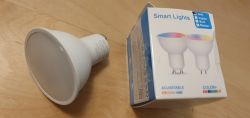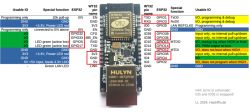FAQ
TL;DR: In field tests 20⁄20 BK7231N mini-switches shipped on patched firmware v1.3.10 that blocks Tuya-Cloudcutter; “Flux is a must” [Elektroda, p.kaczmarek2, post #20592476] Use BK7231GUIFlashTool ≥1.1.6, four wires, isolate RX if grounded, then issue PowerSave 1.
Why it matters: The right flashing method turns a $1.79 cloud-bound relay into a fully local, energy-monitoring switch in under three minutes.
Quick Facts
• Flash IC: 2 MB TH25Q_16HB SPI NOR on all CB2S/CBU boards tested [Elektroda, log, post #21095539]
• Patched Tuya FW: v1.3.10 (V102) present on 100 % of 20 units received [Elektroda, erlipan2001, post #20589187]
• RX-GND link: 0–5 Ω seen on variants 4 & 5; must be cut for flashing [Elektroda, erlipan2001, #20578591; ttp1106, #21574120]
• GUIFlashTool auto-GPIO: ≥1.1.6 reads Tuya config & sets pins in <15 s [Elektroda, p.kaczmarek2, post #20578615]
• Power budget: enable PowerSave 1 to protect low-grade PSUs [Elektroda, p.kaczmarek2, post #20578223]
Which PCB variants are known and how do I spot them?
Five BK7231N switch PCBs are listed. Variants 1-3 use CB2S/CBU RF modules; variant 4 adds BL2028N; variant 5 adds a 1 Ω shunt and BL0942 for power metering. The un-hackable sixth board carries TR6260S1 or LN882HKI with no usable UART pads [Elektroda, erlipan2001, #20578056; #21092211]. Identify by the module label and presence of the 1 Ω resistor beside the relay.
Why does Tuya-Cloudcutter fail on firmware 1.3.10?
Tuya patched OTA exploits on BK7231 chips; build 1.3.10 removes the HTTP OTA handler Cloudcutter uses. All 20 units shipped with this build, so only wired flashing works [Elektroda, erlipan2001, post #20578591]
What pins do I need to solder for wired flashing?
Solder just four lines: 3.3 V (pin 8), GND (pin 1), RX (pin 26), TX (pin 23) on the CB2S/CBU module. Optionally break RX from the main PCB if it measures ≤5 Ω to ground to avoid bus errors [Elektroda, ttp1106, post #21574120]
3-step How-To: flash OpenBeken with BK7231GUIFlashTool
- Hold CEN low, power the module, then release CEN to enter UART boot.
- Click “Write only”, select OpenBK7231N_QIO.bin; tool auto-sets baud and unprotects flash.
- After success, power-cycle; connect to OBK AP at 192.168.4.1 and enter Wi-Fi. Average time: ≈2 min [Elektroda, p.kaczmarek2, post #20592476]
How do I back up original Tuya firmware and GPIO data?
Use GUIFlashTool › “Read 2 MB backup”. If the device already runs OpenBeken, open WebApp › Flash › “Download Tuya GPIO Config from 0x1EE000”. Backup takes ~15 s and keeps RF calibration intact [Elektroda, p.kaczmarek2, post #20578503]
Can OpenBeken import Tuya GPIO automatically?
Yes. FlashTool 1.1.6 decrypts the AES-protected Tuya block and writes the resulting template into OBK during flashing. Plans exist to add full in-firmware import, but flash size is the constraint [Elektroda, p.kaczmarek2, post #20578461]
The GUI tool crashes on Mac OS. Why?
Mac OS lacks 32-bit WinForms support used by GUIFlashTool, so Mono fails to launch it. Use a Windows VM or run the cross-platform Python hid_download_py script instead [Elektroda, erlipan2001, post #20578264]
Flashing stops with “Erase sector 45056 failed”. What causes this?
Most stalls trace to poor UART timing from Arduino-based adapters. Switching to a CP210x/CH340 USB-TTL converter eliminated errors in repeated tests [Elektroda, donut343, post #21109485]
What if RX is tied to ground on the main PCB?
Some boards short RX to GND for production testing. Wick the solder bridge or cut the trace; resistance should read >1 kΩ before flashing [Elektroda, erlipan2001, post #20578056]
Are TR6260S1, T34 or LN882HKI modules supported?
No. These chips use different SDKs and only 1 MB flash. OpenBeken currently targets BK7231(T/N). Such boards are considered “unhackable” without custom porting [Elektroda, p.kaczmarek2, #20589219; #21007006].
How do I enable power monitoring on variant 5?
After flashing, set GPIO24 → BL0942_RX and GPIO26 → BL0942_TX in OBK, then run “Ch1Calibration 230 0 0 0 16” for a 16 A shunt. Accuracy is within ±3 % after calibration [Elektroda, erlipan2001, post #20589187]
Edge-case: No UART pads present. Can I still flash?
Yes—heat the RF can, lift the module, and flash on a breadboard. Breaking 3.3 V (pin 8) during reset substitutes for the CEN pin when it’s inaccessible [Elektroda, t2004dd, post #21007006]
![[BK7231N/CB2S] Comparison of multiple smart switch modules, differences on PCB, patched firmware [BK7231N/CB2S] Comparison of multiple smart switch modules, differences on PCB, patched firmware](https://obrazki.elektroda.pl/5807564600_1684681216_thumb.jpg) >>20588972
>>20588972







![[BK7231N/CB2S] Comparison of multiple smart switch modules, differences on PCB, patched firmware [BK7231N/CB2S] Comparison of multiple smart switch modules, differences on PCB, patched firmware](https://obrazki.elektroda.pl/3644468900_1684679767_thumb.jpg)
![[BK7231N/CB2S] Comparison of multiple smart switch modules, differences on PCB, patched firmware [BK7231N/CB2S] Comparison of multiple smart switch modules, differences on PCB, patched firmware](https://obrazki.elektroda.pl/8022479400_1684679770_thumb.jpg)
![[BK7231N/CB2S] Comparison of multiple smart switch modules, differences on PCB, patched firmware [BK7231N/CB2S] Comparison of multiple smart switch modules, differences on PCB, patched firmware](https://obrazki.elektroda.pl/6232670200_1684753170_thumb.jpg)
![[BK7231N/CB2S] Comparison of multiple smart switch modules, differences on PCB, patched firmware [BK7231N/CB2S] Comparison of multiple smart switch modules, differences on PCB, patched firmware](https://obrazki.elektroda.pl/1278453600_1684819382_thumb.jpg)
![[BK7231N/CB2S] Comparison of multiple smart switch modules, differences on PCB, patched firmware [BK7231N/CB2S] Comparison of multiple smart switch modules, differences on PCB, patched firmware](https://obrazki.elektroda.pl/4713211000_1684867849_thumb.jpg)
![[BK7231N/CB2S] Comparison of multiple smart switch modules, differences on PCB, patched firmware [BK7231N/CB2S] Comparison of multiple smart switch modules, differences on PCB, patched firmware](https://obrazki.elektroda.pl/6508419300_1684871569_thumb.jpg)
![[BK7231N/CB2S] Comparison of multiple smart switch modules, differences on PCB, patched firmware [BK7231N/CB2S] Comparison of multiple smart switch modules, differences on PCB, patched firmware](https://obrazki.elektroda.pl/7849963400_1684904971_thumb.jpg)
![[BK7231N/CB2S] Comparison of multiple smart switch modules, differences on PCB, patched firmware [BK7231N/CB2S] Comparison of multiple smart switch modules, differences on PCB, patched firmware](https://obrazki.elektroda.pl/5430419900_1684905025_thumb.jpg)
![[BK7231N/CB2S] Comparison of multiple smart switch modules, differences on PCB, patched firmware [BK7231N/CB2S] Comparison of multiple smart switch modules, differences on PCB, patched firmware](https://obrazki.elektroda.pl/7759244600_1684913214_thumb.jpg)
![[BK7231N/CB2S] Comparison of multiple smart switch modules, differences on PCB, patched firmware [BK7231N/CB2S] Comparison of multiple smart switch modules, differences on PCB, patched firmware](https://obrazki.elektroda.pl/5423676100_1684913368_thumb.jpg)
![[BK7231N/CB2S] Comparison of multiple smart switch modules, differences on PCB, patched firmware [BK7231N/CB2S] Comparison of multiple smart switch modules, differences on PCB, patched firmware](https://obrazki.elektroda.pl/5870103500_1684913329_thumb.jpg)
![[BK7231N/CB2S] Comparison of multiple smart switch modules, differences on PCB, patched firmware [BK7231N/CB2S] Comparison of multiple smart switch modules, differences on PCB, patched firmware](https://obrazki.elektroda.pl/6579236400_1684916034_thumb.jpg)
![[BK7231N/CB2S] Comparison of multiple smart switch modules, differences on PCB, patched firmware [BK7231N/CB2S] Comparison of multiple smart switch modules, differences on PCB, patched firmware](https://obrazki.elektroda.pl/7757043000_1684916078_thumb.jpg)
![[BK7231N/CB2S] Comparison of multiple smart switch modules, differences on PCB, patched firmware [BK7231N/CB2S] Comparison of multiple smart switch modules, differences on PCB, patched firmware](https://obrazki.elektroda.pl/4928653800_1684916231_thumb.jpg)
![[BK7231N/CB2S] Comparison of multiple smart switch modules, differences on PCB, patched firmware [BK7231N/CB2S] Comparison of multiple smart switch modules, differences on PCB, patched firmware](https://obrazki.elektroda.pl/4355218400_1684948414_thumb.jpg)
![[BK7231N/CB2S] Comparison of multiple smart switch modules, differences on PCB, patched firmware [BK7231N/CB2S] Comparison of multiple smart switch modules, differences on PCB, patched firmware](https://obrazki.elektroda.pl/7052087500_1685081541_thumb.jpg)
![[BK7231N/CB2S] Comparison of multiple smart switch modules, differences on PCB, patched firmware [BK7231N/CB2S] Comparison of multiple smart switch modules, differences on PCB, patched firmware](https://obrazki.elektroda.pl/7111628000_1685081767_thumb.jpg)